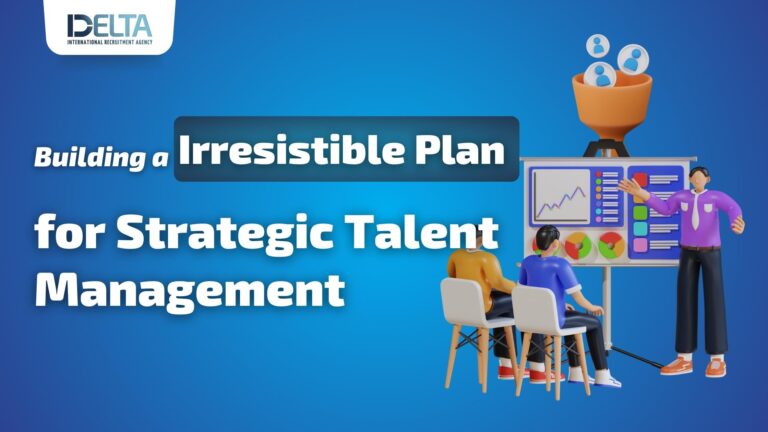Human resource mostly depends on the efficiency with which recruiters connect hiring businesses with qualified job seekers. Here we are going to highlight the challenges that come with recruitment and provide insights into how these recruitment challenges can be overcomed.
Recruitment is an important part of any company’s success, as it helps to attract and retain the best talent. However, it is also a complex and challenging process, requiring a notable outlay of time, resources, and expertise.
Through this, we aim to educate you on the complexities of the recruitment process and importance of effective recruitment in an organization’s success. So, they can attract, screen, and select the best talent for their organizations and avoid these challenges in recruitment.
Things that makes recruitment a challenge:
Recruiting new employees is a critical and complex process for any organization. Hiring the right people can greatly impact the success and growth of a company. However there are still some challenges in recruitment that make this process difficult. Let’s go through them Step-By-Step:
1. Attracting The Right Talent
Finding and attracting the right talent is one of the hardest challenges in recruitment process. Because, companies must have top talent to achieve their business’s success goals. But, hiring best talent can be difficult due to multiple reasons, which includes:
- Difficulty in reaching the right audience:
Companies may struggle to reach the right audience for their open positions, which can make it really hard to find required number of qualified candidates. Let’s say, if a company is seeking to fill a specific role, maybe it will be hard to find candidates with the right skills and experience.
Quick Tip: Social Media platforms like LinkedIn and Facebook can be really helpful to find the right candidates. Because, these platforms have large number of users which may also those people who are you looking for.
- Limited pool of candidates: The limited number of right fits can make it hard for companies to find the right fit for their open positions. This can be challenging in specific industries where usually there is a shortage of talent, such as tech or healthcare.
Quick Tip: Consider expanding your search beyond your immediate area. Look for candidates in other cities, states, or even countries if the job allows for remote work to solve this recruitment challenge.
- Balancing the need for diversity and qualifications:
Many employers struggle to balance their need for diversity with the need to hire individuals with the right qualifications. For example, they may want to hire individuals from diverse backgrounds to bring new perspectives and ideas to the company, but also need to ensure that candidates have the right skills and experience for the role.
Quick Tip: Set specific diversity goals for your hiring process and make sure everyone involved in the process is aware of them.
2. Screening and Selection
Screening and selection is another challenge in the recruitment process. This is a time-consuming process that involves evaluating a large number of applicants and making decisions about which candidates are the best fit for the role. Some of the key recruitment challenges in this process include:
- Evaluating the right fit:
Evaluating the right fit can be challenging, as there are no single criteria for success. Like sometimes a candidate may have the right skills and experience, but may not well fit with the company culture.
Quick Tip: If you have a candidate that your not sure about, you should consider one more interview round in which you may try giving different scenarios. Through which, you can check how may candidate respond to those situations which will give your more clearance about if candidate is a well fit-in.
- Time constraints:
Screening and selection can be a time taking process, and companies may struggle to allocate the resources that are needed to evaluate all of the applicants. This can lead to hasty hiring decisions and a higher risk of making a poor hire.
Quick Tip: Try identifying the most important job requirements and make your hiring process based on those. By doing this you can make a decision quickly and efficiently and can easily resolve this recruitment challenge.
3. Salary and Benefits Negotiation
Salary and benefits negotiations are a important part of the hiring process, it may not seem to be one of a big challenges in recruitment. But, this help companies to attract and retain top talent for a long-time. However, this stage of the hiring process can also have multiple challenges for companies, like:
- Balancing the budget and employee expectations:
To recruit and keep top people, businesses need to provide market competitive salaries and perks without breaking the bank. This can be particularly hard in a tight labor market where demand for top talent is very high.
Quick Tip: Be clear with your employees about the budget constraints and what they can expect in terms of compensation, benefits, and other perks. This can help manage their expectations and avoid disappointment.
- Offering benefits that attract and retain top talent:
Companies should also offer benefits, which will help in attract and retain top talent. These may include flexible work hours, health insurance, and retirement benefits. These benefits can be expensive, and companies must balance the cost of offering these benefits with their budget constraints and can create many challenges in recruitment.
Quick Tip: Offer competitive compensation such as salaries, bonuses. This can help attract and retain top talent and keep your organization competitive.
4. Onboarding and Integration
In the recruitment process, onboarding and integration are important steps. Because they help new hires feel welcomed and adjust to their new role and the company culture. However, these steps also present several things, including:
- Lack of clear communication:
Companies may struggle to communicate effectively with new hires during the onboarding process, which can lead to confusion and a lack of understanding about the company and their role. This can make it difficult for new hires to quickly get up to speed and be productive.
Quick Tip: Avoid using complex language or industry jargon that may be difficult to understand. Use simple and concise language that is easy to understand for everyone.
- Inconsistent onboarding processes:
Having inconsistent onboarding processes, can make it difficult for new hires to know what to expect. As new hires may miss important information or not receive the support they need to be successful in their new role.
Quick Tip: Create a standardized onboarding process that is consistent for all new hires. This can help ensure that everyone receives the same information, training, and support.
- Limited resources for integration:
Companies may have limited resources for integrating new hires into the company culture and their role, which can make it difficult for new hires to feel supported and valued. This can also result in a lack of integration and a lack of understanding about the company’s goals and culture, which can impact new hires’ ability to be productive and contribute to the company’s success.
Quick Tip: Prioritize communication with new hires to ensure that they feel supported and informed. This can help build a positive relationship and encourage engagement.
5. Retention and Employee Engagement
Keeping employees and getting them invested in the company’s success are two of the biggest recruitment challenges, that businesses must overcome in today’s dynamic marketplace. Some of the challenges associated with retention and employee engagement are:
- Keeping top talent from leaving:
Most of the top talent leave companies because they see lack of growth and development opportunities, poor management or and poor work-life balance. Companies must overcome these obstacles to retain top-talent and have lower turn-over rates.
Quick Tip: Recognize and reward high-performing employees through bonuses, promotions, and other incentives. This can help boost morale and increase retention.
- Addressing employee disengagement:
If a employee is disengaged with company’s successes, then this can cause lack of less productivity and less invested in given tasks. Lack of opportunities for growth and development along with poor communication can cause employee disengagement.
Quick Tip: Regular feedback can help employees understand how they are performing and provide an opportunity to course-correct. This can also help them feel valued and invested in their work.
Solutions to Recruitment Challenges:

We have talked enough about difficulties and challenges that comes with the recruitment process. Now let’s uncover the solution to these recruitment challenges and help you hire efficiently:
Using social media to attract right talent is effective
Sometimes finding and hiring right candidates is one of the biggest challenges in recruitment and it can takes a lot of resources. Because of that, companies should be very precise with their way of reaching the desired audience. Social Media and Job Boards can really help to find the best fit for your need. Additionally, offering market competitive salary can be a great attention grabber to attract top talent.
Offering market competitive salary and benefits along with clear onboarding process
In the first place, it is really hard to find the right talent and after that another recruitment challenge comes also which what are we offering to attract. If your seeking to attract best candidates for your role then you should be clear with these three things:
- Competitive Salary
- Benefits
- Onboarding Process
Competitive Salary:
Offering competitive compensation is one of the best way to attract
candidates and solve one of the most daunting recruitment challenges. You should offer market competitive
salaries in order to attract the best talent for your team. Having unsatisfactory compensation is one of the
main reason, that mostly best candidates looking for better opportunities in market.
Benefits:
Having great perks and benefits with market competitive salary is one of the finest
way to retain and attract candidates that your looking for. Mostly these benefits include medical insurance,
flexible work hours and carrier development opportunities.
Onboarding Process:
The more difficult your onboarding process would be, the more talent you
will lose. Therefore, it should be easy and simple. Just simplify and explain the onboarding process clearly on
the platform your advertising and candidates while interview round, so candidates have an idea on what to expect
and you can easily get through this recruitment challenge.
However, if you don’t want to go through the hassle of hiring candidates yourself then you should see a recruitment agency that can help you in hiring process.
Interact and provide feedback opportunities with employees
It is really hard to retain top talent, mostly an employee leaves the company due to serval reasons. It is important to retain best employees because this can cause high turnover rates. Few of these reasons may include being un-valued or un-appreciated which can cause disengagement to work and can also cause less productivity overall.
To overcome this recruitment challenge, companies can implement employee engagement programs that address the specific needs and concerns of their employees. Additionally, companies can recognize and reward employees for their contributions, provide opportunities for employees to give feedback, and regularly assess the overall level of employee engagement within the organization.
To sum this up, recruitment is a complex and challenging process that requires companies to effectively manage each step of the process. By understanding and overcoming these recruitment challenges associated with each step, companies can attract and retain top talent, and support new hires in their role and the company culture. This can help companies achieve their goals and succeed in a competitive market.
Related FAQ’s
What are the major challenges in recruitment?
The major challenges in recruitment include attracting the right candidates, dealing with a high volume of applications, identifying qualified candidates, providing a positive candidate experience, and ensuring a diverse candidate pool.
How can companies find the right talent?
Companies can attract the right candidates by creating a compelling job description, using social media and other recruitment channels to target specific candidate pools, and providing competitive compensation and benefits packages.
How to identify qualified candidates?
Recruiters can identify qualified candidates by using structured interviews, conducting skills tests and assessments, checking references, and using data and analytics to identify the most qualified candidates.
Recruitment: Discover 5 Recruitment Challenges and their Solutions




